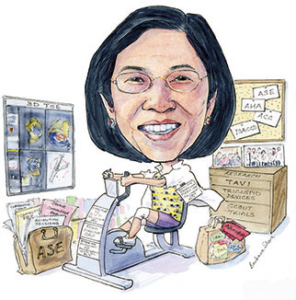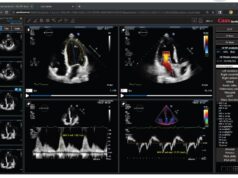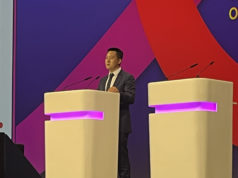
Rebecca Hahn (Center for Interventional Vascular Therapy, Columbia University Medical Center, New York, USA) has been at the forefront of the developing field of interventional echocardiography. In this interview, she talks about the important role that the heart team, specifically the echocardiographer, plays in structural heart interventions and her current research interests. She also gives advice to interventional echocardiographers who are just starting their career and explains she does not watch medical dramas because “it is too annoying to see X-rays backwards”.
Why did you decide to go into medicine and why, in particular, interventional echocardiography?
I was a biology major in university, and medicine seemed a logical choice—my brother, who was two years ahead of me, had already started medical school at Washington University, St Louis, USA (he is now assistant dean of Faculty Affairs at Brown University Medical School, Providence, USA) and encouraged me to apply. My interest in echocardiography partly stems from my love of the visual arts and drawing. Being able to think in three-dimensions but image in two-dimensions is integral to this new subspecialty of echocardiography.
The choice to go into interventional imaging was also logical. When I came to Columbia University in 2007, they had just recently started their transcatheter programme (transcatheter aortic valve implantation and MitraClip) and at that time, 3D echocardiography—in particular, the first commercial 3D transoesophageal probe—was being developed. It was a fortuitous convergence of technologies that would be the beginning of a new field: interventional echocardiography! Martin Leon saw the range of interventional possibilities that imaging could help to advance and then hired me away from the regular echo lab and into the cath lab. He also understood the need to build the “heart team” and that imagers would be one of the keys to the programme’s success.
Who have been your career mentors?
My first mentor after fellowship was Dr Allen Mogtader. He is an understated and unassuming echocardiographer who really taught me that excellence in what we do means a lot. He was the most compulsive imager that I have ever met. A commitment to performing careful and systematic imaging to interpret the cardiac anatomy and pathology correctly has been a great advantage in my work in interventional echocardiography.
As mentioned, Dr Leon has both my respect and gratitude. He has created a culture within the interventional group (especially our structural heart disease centre) of collaboration, intensity, and creativity that has made “work” our “playground”. I am having the greatest productivity of my career while truly enjoying the work I do with people I respect.
During your career, what has been the most important development in echocardiography?
Echocardiography is far from a mature modality and continues to advance. During my career to date, the most important development has been 3D imaging. We no longer have to mentally-reconstruct a 3D structure from 2D images. This improved morphologic understanding and accuracy has catapulted echocardiography into the forefront of the structural heart disease interventions and innovations.
Furthermore, the creation of the heart team has changed the role of the echocardiographer. As our role became more integral to procedural success, interventionalists—as well as device companies—have begun to integrate imaging into procedural planning as well as device development.
What has been the biggest disappointment? For example, something you hoped would change practice but did not?
Perhaps the most underused echocardiographic development has been echocardiographic contrast. The use of contrast for endocardial border detection remains a major advancement, transforming the inadequate image to a diagnostic image. Very few simple solutions could make such a dramatic impact on diagnosis and clinical outcomes and yet despite numerous studies proving the added benefit of contrast, the now rescinded “black box” warning from the FDA reversed the momentum for this technology. Although shown to be safe, exposure of cardiology trainees to standard use of contrast has been limited and contrast remains underused.
Contrast has also been used as a perfusion agent for detection of coronary artery disease. Limitations to the techniques have been difficult to overcome and after great promise, there are few institutions that use contrast for perfusion. Nonetheless, echocardiographic contrast has not disappeared and I can only hope that use will continue to increase.
The heart team is often said to be vital for structural heart interventions. Why is it important to have an imaging specialist in such a team?
Although the heart team concept arose to optimise treatment of complex patients, it was popularised by transcatheter aortic valve implantation (TAVI). The imager is the “eyes” of the team, using multiple modalities to determine the severity of disease, define the morphology of the structural abnormality, and provide guidance in the procedures. Some procedures, such as those for the mitral or tricuspid valve, are primarily guided by echocardiography, making the imager essential to procedural success.
The joint and shared decision-making that occurs for every patient and in every procedure requires the mutual respect and collaboration of all the team members. My voice is as important as the surgeon or interventionalist. Much of the success of our team stems from the leadership of the director of the Structural Heart & Valve Center, Dr Susheel Kodali. His integrity, work ethic and upbeat but calm demeanour inspire all of us to do our best for our patients.
What is the role of echocardiography in TAVI?
Echocardiography is used throughout the TAVI process. Echocardiography is the primary imaging modality used pre-procedurally to determine the severity of aortic stenosis and determines the appropriate patient for the procedure. When transoesophageal echocardiography (TOE) is used intraprocedurally it can be used to confirm or replace computed tomography (CT) measurements of annular area/perimeter and assess the risk for complications such as annular rupture and left main coronary artery occlusion. Additionally, echocardiography can assess post-implant device function and rapidly diagnose complications. Use of echocardiography has in some studies, been shown to reduce contrast use and fluoroscopy time, as well as save lives!
What are the potential advantages and disadvantages of fusion imaging during TAVI?
Fusion imaging today has limited utility for TAVI. However as we understand how to track the 3D image in space, there is great potential to use echocardiographic images to confirm accurate positioning, location of coronaries, predict and locate paravalvular regurgitation. Fusion imaging has the promise of reducing complications as well as contrast use.
With systems available today, co-registration needs to be performed using two orthogonal fluoroscopic images, increasing exposure of the interventionalist and imager. Also, fiduciary points placed on the echocardiographic image, which then is projected onto the fluoroscopic image, cannot track cardiac motion.
However, fusion imaging already has great utility for a number of other procedures: transseptal puncture, surgical valve paravalvular regurgitation closure, percutaneous edge-to-edge repair (MitraClip, Abbott Vascular).

Imaging may be even more important for percutaneous mitral valve interventions than it is in TAVI. In your view, what imaging modalities should be used during percutaneous mitral valve interventions (repair and replacement)?
Guiding procedures in real time requires 3D TOE. The accurate use of this modality requires special training and a comprehensive understanding of 3D anatomy. We currently have a special one year fellowship in interventional echocardiography.
You are the principal investigator of the SCOUT trial, which is investigating a new percutaneous approach to tricuspid regurgitation. Why are new approaches to tricuspid regurgitation needed?
Natural history studies have shown that severe tricuspid regurgitation is associated with increased mortality. Despite guideline recommendations, this disease is significantly untreated by surgical approaches because of a number of misconceptions:
- Surgical treatment of left heart disease can “fix” functional tricuspid regurgitation
- Severe functional tricuspid regurgitation does not affect outcomes
- Simultaneously surgical treatment of left valve disease and functional tricuspid regurgitation increases operative mortality.
We thus have a large population of patients with treated left heart valve disease, but severe residual functional tricuspid regurgitation. The operative mortality of isolated tricuspid valve disease is higher than for other single valve diseases and the re-operative mortality in these patients is also very high. Furthermore, our successes in TAVI and transcatheter mitral valve repair has created a new population of patients who were not felt to be surgical candidates prior to the initial transcatheter procedure, but who now have severe functional tricuspid regurgitation.
Of the research you have been involved with, what do you think has had the biggest impact on clinical practice?
TAVI has undoubtedly has had the greatest clinical impact, allowing us to treat “inoperable”, “high-risk” and now “intermediate-risk” patients without open heart surgery. Additionally, the ability to treat failed surgical valves with this technology has changed the approach to surgical disease. Finally, TAVI has brought patient choice into the algorithm.
Aside from SCOUT, what are your current research interests?
I am continuing to work in the TAVI field, using the large randomised (and continued access) trials to define the determinants of outcomes as we move into the lower surgical risk patients. I believe that understanding these factors will help inform physicians and patients when making decisions about surgery or transcatheter replacement.
I am also the core lab for other tricuspid device trials and through these trials, I hope to be able to define methods for quantifying tricuspid regurgitation as well as determine which parameters should be used for future trials.
There are also a number of mitral devices for which Columbia University is participating in the early feasibility trials. I believe these show great promise.
As an interventional echocardiography fellow supervisor, what key advice do you give to those just starting their career?
This is an evolving field, and keeping up with advancements in the structural heart disease and imaging field is a life-long commitment. The hours are long and you must be truly dedicated to this field to work in it.
Which has been your most memorable case and why?
It is always gratifying when clear imaging has played a role in determining favourable outcomes. We have had a number of patients for whom we predicted left main occlusion, allowing for pre-implant protection of the coronary artery. We have had two cases in which the patient could not have any contrast. Thus not only was the initial CT inadequate, but no contrast could be used in the procedure. Ultrasound was used for vascular access, and TOE was essential for sizing of the valve, risk assessment for coronary occlusion, positioning of the valve and final assessment of valve function. Without TOE, these patients could not be treated.
Of the numerous TV dramas set in hospitals, which one do you think is the most realistic (or rather, the least unrealistic!)?
I must admit, that I do not watch these TV hospital dramas—I find it too annoying to see X-rays backwards or medical terminology misused!
Outside of medicine, what are your hobbies and interests?
I love spending my free time with family and going travelling; last year, for example, I made two trips to Namibia to visit my daughter who was teaching there.
I do extensive volunteering for the American Society of Echocardiography including committee chair positions, writing committees, conference programme chair (scientific sessions and other programmes) and humanitarian missions. Also, I exercise regularly because of a prior sports injury/surgery on my knee.
Factfile
Present academic rank and position
- Professor of Medicine at Columbia University College of Medicine, New York, USA
- Director of Interventional Echocardiography, Center for Interventional Vascular Therapy, Columbia University, New York, USA
- Echo director, Cardiovascular Research Foundation (CRF); responsible for providing high quality and cost effective echocardiography interpretation services and enhancing the quality and quantity of the academic output related to the ECHO core laboratory in support of the education and research mission of CRF.
Medical training
- BA biology, Harvard University, Cambridge, USA
- MD Medicine, Washington University in St Louis, St Louis, USA
- Intern, Internal Medicine, New York Hospital/Cornell, New York, USA
- Resident, Internal Medicine, New York Hospital/Cornell, New York, USA
- Assistant chief resident, Internal Medicine, New York Hospital/Cornell, New York, US
- Fellow, Cardiology, New York Hospital/Cornell
- Research fellow, Cardiology, New York Hospital/Cornell
Professional memberships
- American Society of Echocardiography
- American College of Cardiology
- American Society of Echocardiography
- American Heart Association
Selected published research
- Hahn RT, et al. Guidelines for performing a comprehensive transesophageal echocardiographic examination: Recommendations from the American Society of Echocardiography and the Society of Cardiovascular Anesthesiologists. J Am Soc Echocardiogr 2013; 26:921-964.
- Hahn RT, et al. Recommendations for comprehensive intraprocedural echocardiographic Imaging During TAVR. J Am Coll Cardiol Img 2015;8:261–87.
- Hahn RT. State-of-the-art review of echocardiographic review in the evaluation and treatment of functional tricuspid regurgitation. Cir Cardiovasc Imaging 2016; 9: Epub













